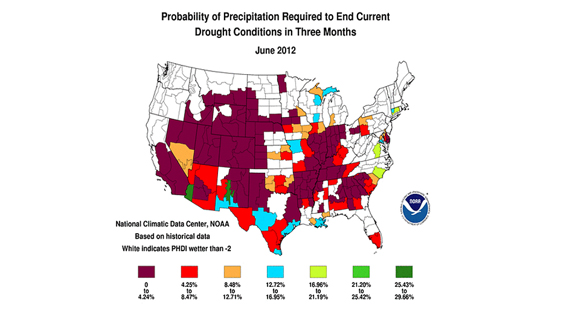U.S. Faces Worst Drought Since 1956
Drought grips 55% of the US mainland causing a shortfall in crop production, with very low chances of it ending any time soon

A map of the continental US, where brown shows below average crop growth, and green above average. Photo: NASA
Satellite imagery collected by NASA’s Terra satellite shows how the worst drought in the past half century has affected crop yields around the country. According to NASA’s Earth Observatory,
This drought, like all extreme weather events, has its direct cause in a complex set of atmospheric conditions that produce short-term weather. However, weather occurs within the broader context of climate, and there’s widespread agreement among scientists that the climate is changing due to human activity.
The map contrasts plant health in the central United States between June 25 and July 10, 2012, against the average conditions between 2002 and 2012. Brown areas show where plant growth was less vigorous than normal; cream colors depict normal levels of growth; and green indicates abnormally lush vegetation.
Drought conditions now extend to 55% of the U.S. mainland, with devastating effects on the nation’s breadbasket. According to the Financial Post,
The corn crop is in the greatest danger. Plants are trying to pollinate to let ears fill with kernels, a period when adequate moisture is vital for final yields. The United States ships more than half of all world exports of corn, which is made into dozens of products, from starch and ethanol to livestock feed.
The Financial Post says that the U.S. Department of Agriculture reduced its estimates of national corn and soybean production and notes that there will likely be trickle-down effects affecting the food security of the rest of the planet as the typically huge export rate of American crops dries up.
The National Oceanic and Atmospheric Administration’s National Climate Data Center has put out a drought forecast suggesting that there is quite a low chance that the drought conditions will end any time soon, with many states in the midwest having only a 0—4.24% chance of the drought ending in the next three months.

The chances of the drought ending in the next 3 months remain fairly low across the board, with purple the lowest chance and green the highest. Photo: NOAA
More from Smithsonian.com:
70 Percent of Illinois Is In A Drought (And It’s Better Off than Indiana)
/https://tf-cmsv2-smithsonianmag-media.s3.amazonaws.com/accounts/headshot/smartnews-colin-schultz-240.jpg)
/https://tf-cmsv2-smithsonianmag-media.s3.amazonaws.com/accounts/headshot/smartnews-colin-schultz-240.jpg)